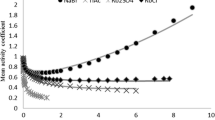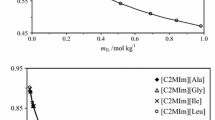Abstract
The specific ion theory (SIT) is a convenient ion activity coefficient model that is often used in solubility and solution equilibrium studies. However, its accuracy is limited. The SIT model can be improved by adding higher-order terms, and by allowing cation–cation, and anion–anion interactions. However, extensions of the SIT model tend to lead to a rapidly increasing number of higher-order interaction parameters that need to be known for reliable predictions. Using the analogy of multicomponent extensions of the Redlich–Kister/Margules model, this paper determines how far a virial-type activity coefficient model can be extended before it becomes unmanageable. It was found that a second-order extension of the SIT model is manageable. A first-order model is sufficient to describe Harned’s Rule satisfactorily. It is found that the addition of like-ion interaction parameters (i.e., cation–cation interactions and anion–anion interactions) to the SIT model substantially improves Harned’s Rule calculations, with an error reduction of over 50%. The ion interaction parameters are presented. Like-ion interactions should be interpreted as competitive effects between ion-water interactions rather than direct ion-ion interactions. Using concentration or mole per kg solution (modified molality) as a measure of abundance does not improve the accuracy of a first-order ESIT model but the modified molality scale does improve the accuracy of a 2nd-order ESIT model.






Similar content being viewed by others
Availability of data and material
Harned Coeff SIT.xlsx (Excel file containing the calculation of like-ion interactions in Table 5, as well as Figs. 5 and 6).
Code availability
Not applicable.
References
Oliver, E.D.: Multicomponent Margules equations. Ind. Eng. Chem. Fundam 7, 335–335 (1968)
Mukhopadhyay, B., Basu, S., Holdaway, M.J.: A discussion of Margules-type formulations for multicomponent solutions with a generalized approach. Geochim. Cosmochim. Acta 57, 277–283 (1993)
Pitzer, K.S.: Thermodynamics of electrolytes. I. Theoretical basis and general equations. J. Phys. Chem. 77, 268–277 (1973)
Pitzer, K.S., Mayorga, G.: Thermodynamics of electrolytes. II. Activity and osmotic coefficients for strong electrolytes with one or both ions univalent. J. Phys. Chem. 77, 2300–2308 (1973)
Pitzer, K.S., Mayorga, G.: Thermodynamics of electrolytes. III. Activity and osmotic coefficients for 2–2 electrolytes. J. Solut. Chem. 3, 539–546 (1974)
Pitzer, K.S., Kim, J.J.: Thermodynamics of electrolytes. IV. Activity and osmotic coefficients for mixed electrolytes. J. Am. Chem. Soc. 96, 5701–5707 (1974)
Abrams, D.S., Prausnitz, J.M.: Statistical thermodynamics of liquid mixtures: A new expression for the Excess Gibbs energy of partly or completely miscible systems. Am. Inst. Chem. Eng. J. 21, 116–128 (1975)
Anderson, T.F., Prausnitz, J.M.: Application of the UNIQUAC equation to calculation of multicomponent phase equilibria. 1. Vapor-liquid equilibria. Ind. Eng. Chem. Proc. Des. Dev. 17, 552–561 (1978)
Weidlich, U., Gmehling, J.: A modified UNIFAC model. 1. Prediction of VLE, hE, and γ∞. Ind. Eng. Chem. Res. 26, 1372–1381 (1987)
Gmehling, J., Li, J., Schiller, M.: A modified UNIFAC model. 2. Present parameter matrix and results for different thermodynamic properties. Ind. Eng. Chem. Res. 32, 178–193 (1993)
Gmehling, J., Lohmann, J., Jakob, A., Li, J., Joh, R.: A modified UNIFAC (Dortmund) model. 3. Revision and extension. Ind. Eng. Chem. Res. 37, 4876–4882 (1998)
Gmehling, J., Wittig, R., Lohmann, J., Joh, R.: A modified UNIFAC (Dortmund) model. 4. Revision and extension. Ind. Eng. Chem. Res. 41, 1678–1688 (2002)
Jakob, A., Grensemann, H., Lohmann, J., Gmehling, J.: Further development of Modified UNIFAC (Dortmund): Revision and Extension 5. Ind. Eng. Chem. Res. 45, 7924–7933 (2006)
Preis, W., Gamsjager, H.: Thermodynamic investigation of phase equilibria in metal carbonate-water-carbon dioxide systems. Monatsh Chem. 132, 1327–1346 (2001)
Komninos, N.P., Rogdakis, E.D.: Geometrical investigation and classification of three-suffix Margules binary mixtures including single and double azeotropy. Fluid Phase Equil. 494, 212–227 (2019)
Zagarzadeh, L., Elliott, J.A.W.: Comparison of the osmotic virial equation with the Margules activity model for solid-liquid equilibrium. J. Phys. Chem. B 123, 1099–1107 (2019)
Song, Z., Zhou, T., Qi, Z., Sundmacher, K.: Extending the UNIFAC model for ionic liquid-solute systems by combining experimental and computational databases. Am. Inst. Chem. Eng. J. 66, e16821 (2019)
Machado, G.D., Castier, M., Voll, A.P., Cabral, V.F., Cardozo-Filho, L., Aranda, D.A.G.: Ethanol and methanol UNIFAC subgroup parameter estimation in the prediction of the liquid-liquid equilibrium of biodiesel systems. Fluid Phase Equil. 488, 79–86 (2019)
Gao, Y., Li, C., Xia, S., Ma, P.: Estimation and correlation of phase equilibrium of CO2-hydrocarbon systems with PRMHV2-UNIFAC and PRMHV2-NRTL models. J. Chem. Eng. Data 65, 655–663 (2020)
De Visscher, A., Vanderdeelen, J., Königsberger, E., Churgalov, B.R., Ichikuni, M., Tsurumi, M.: IUPAC-NIST Solubility Data Series. 95. Alkaline earth carbonates in aqueous systems. Part 1. Introduction, Be and Mg. J. Phys. Chem. Ref. Data 41, 013105 (2012)
De Visscher, A., Vanderdeelen, J.: IUPAC-NIST Solubility Data Series. 95. Alkaline earth carbonates in aqueous systems. Part 2. Ca. J. Phys. Chem. Ref. Data 41, 023105 (2012)
Crea, F., De Stefano, C., Irto, A., Milea, D., Pettignano, A., Sammartano, S.: Modeling the acid-base properties of molybdate(VI) in different ionic media, ionic strengths and temperature, by EDH, SIT and Pitzer equations. J. Molec Liq 229, 15–26 (2017)
Yalcintas, E., Cevirim-Papaioannou, N., Gaona, X., Fellhauer, D., Neck, V., Altmaier, M.: Solubility of U(VI) in chloride solutions. III. The stable oxides/hydroxides in MgCl2 systems: Pitzer activity model for the system UO22+–Na+–K+–Mg2+–H+–OH––Cl––H2O(l). J. Chem. Thermodyn. 131, 375–386 (2019)
Altmaier, M., Yalcintas, E., Gaona, X., Neck, V., Müller, R., Schlieker, M., Fanghängel, T.: Solubility of U(VI) in chloride solutions. I. The stable oxides/hydroxides in NaCl systems, solubility products, hydrolysis constants and SIT coefficients. J. Chem. Thermodyn. 114, 2–13 (2017)
Gallego-Urrea, J.A., Turner, D.R.: Determination of pH in estuarine and brackish waters: Pitzer parameters for Tris buffers and dissociation constants for m-cresol purple at 298.15 K. Mar. Chem 195, 84–89 (2017)
Hashemzadeh, M., Liu, W.: Analysis of iron and copper speciation and activities in chloride leaching solutions of high ionic strength. Hydrometallurgy 192, 105262 (2020)
Tasic, A., Djordjevic, B., Grozdanic, D., Afgan, N., Malic, D.: Vapor-liquid equilibria of the systems acetone-benzene, benzene-cyclohexane and acetone-cyclohexane at 25°C. Chem. Eng. Sci. 33, 189–197 (1978)
Pitzer, K.S.: Ion interaction approach: Theory and data correlation. In: Pitzer, K.S. Activity Coefficients in Electrolyte Solutions, 2nd edn. CRC Press (1991)
De Visscher, A.: Salting out and salting in of benzene in water: A consistency evaluation. Monatsh. Chem. 149, 231–236 (2018)
Hamer, W.J., Wu, Y.C.: Osmotic coefficients and mean activity coefficients of uni-univalent electrolytes in water at 25 °C. J. Phys. Chem. Ref. Data 1, 1047–1099 (1972)
Rowland, D., May, P.M.: An investigation of Harned’s rule for predicting the activity coefficients of strong aqueous electrolyte solution mixtures at 25 °C. J. Chem. Eng. Data 62, 310–327 (2017)
Debye, P., Hückel, E.: Zur Theorie der Elektrolyte. I. Gefrierpunktserniedrung und verwandte Erscheinungen. Phys. Z. 24, 185–206 (1923)
Guggenheim, E.A.: The specific thermodynamic properties of aqueous solutions of strong electrolytes. Phil. Mag. 19, 588–643 (1935)
Scatchard, G.: Concentrated solutions of strong electrolytes. Chem. Rev. (Baltimore) 19, 309–327 (1936)
Krumgalz, B.S., Pogorelsky, R., Pitzer, K.S.: Volumetric properties of single aqueous electrolytes from zero to saturation concentration at 298.15 °K represented by Pitzer’s ion-interaction equations. J. Phys. Chem. Ref. Data 25, 663–689 (1996)
Krumgalz, B.S., Pogorelsky, R., Sokolov, A., Pitzer, K.S.: Volumetric ion interaction parameters for single-solute aqueous electrolyte solutions at various temperatures. J. Phys. Chem. Ref. Data 29, 1123–1140 (1996)
Funding
Not applicable.
Author information
Authors and Affiliations
Corresponding author
Ethics declarations
Conflicts of interest/Competing interests
Not applicable.
Additional information
Publisher’s Note
Springer Nature remains neutral with regard to jurisdictional claims in published maps and institutional affiliations.
Electronic Supplementary Material
Below is the link to the electronic supplementary material.
Rights and permissions
About this article
Cite this article
De Visscher, A. Extended Specific Ion Theory (ESIT): Theoretical development and application to Harned’s rule. J Solution Chem 51, 711–733 (2022). https://doi.org/10.1007/s10953-022-01152-4
Received:
Accepted:
Published:
Issue Date:
DOI: https://doi.org/10.1007/s10953-022-01152-4




